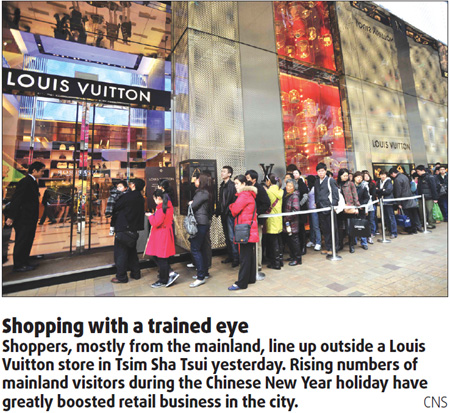The Year of the Tiger investment traps
Updated: 2010-02-18 06:31
(HK Edition)
|
|||||||||
The bullish Year of the Ox has come to an end. Looking ahead to the Year of the Tiger, will the stock market spring like a tiger, or swing like a monkey?

This year, Pegasus predicts the HSI will rise to 30,000 points in a blue-sky scenario, 28,000 points in a middling case and 26,000 points in the worst case. The target for the Hang Seng China Enterprises Index is 18,000 points. The price of gold will rise to USD 1,300 per ounce, the price of crude oil will rise to US$90 per barrel, and the mainland A-share index will rise to the 4,000-4,500 level.
However, there are also some negative factors that will make the market volatile, though these negative factors are pitfalls rather than real crises. Investors should avoid falling into these pitfalls. To this end, I share you with the six investment traps, bubbles and opportunities.

First comes inflation expectation. The US CPI rose 2.7 percent in December, lower than what economists expected. Federal Reserve officials have said that inflation will remain low in the following 12 to 18 months. If the inflation figures rise unexpectedly in emerging markets, the stock market may be volatile. Yet, the inflation risk is low, since there is an oversupply problem in China, so investors should not worry too much about this.
Second is interest rate hikes. The recovery in the US is slow, and, accordingly, so is the pace of rate increases. During the last cycle of rate hikes, the US economy recovered in the third quarter of 2003, but the Fed held the interest rate unchanged until it recorded eleven consecutive quarters of GDP expansion in mid-2004. In the current cycle, the US GDP growth returned positive in the third quarter of 2009, so it is still too early to think about a rate hike. In China, the central bank will try to postpone the timetable for rate increases so as to prevent stoking hot money inflows, or it may let the yuan appreciate to ease inflation.
The third pitfall is "exit strategy". The developed markets will not withdraw stimulus funding at this moment, but the emerging markets have already begun to "exit". The People's Bank of China raised the banks' required reserved ratio (RRR) by 50 basis points. India's central bank also increased the RRR and Brazil tightened its foreign exchange policies. Although the implemented "exit strategy" of each of these countries is putting pressure on their markets, the developed markets still cannot "exit".
Fourth, the US government may stop buying debts. During the financial tsunami, the Federal Reserve bought bonds and pushed down bond yields. However, in tandem with the economic recovery, the Fed will stop buying bonds and thus the bond yields will rise again. In November 2009, the 10-year Treasury yield was around 3.2 percent. Currently, the yield is around 3.6 percent. If the yield accelerates upwards, money will flow from the stock market to the bond market, and the stock market will correct. Also, if mortgage rates go up, the recovery of the housing sector will be affected.
The fifth pitfall is the "W-shaped recovery". Nobel Prize winner Paul Krugman has warned repeatedly that the probability of the double-dip in the US is around 40 percent. I don't rule out such a possibility. The market always changes. Anything could happen. Now there are two factors that may trigger a double-dip: the first is weaker US consumption, the second is the European debt crisis.
Last, but most important, is the trade friction between China and the US. China's exports rose 17.7 percent in December while the market expected a 5 percent increase only. As the US unemployment rate remains high, the American government may impose more tariffs on imported goods from China or other types of "protectionism". If China decides to counter-attack, the trade friction will finally turn into a "lose-lose" situation.
However, as international trade interlocks countries around the world, I believe China and the US will eventually compromise with each other and the crisis will be solved.
Coming into the Year of the Tiger, money will continue to flow from the developed markets to the emerging markets. In particular, I am optimistic about regions like BRIC (Brazil, Russia, India, China), small-caps, the Middle East, Vietnam and Africa, and sectors like technology, Asian domestic consumption, medical, clean energy, other energy, gold mining and REITs as well. Investors should notice the aforementioned six pitfalls and the following thirteen risks: the Sino-US relationship, Iran politics, European countries' fiscal balance, financial regulations, the chain effect after Iceland's crisis, the US's housing prices, Japan's political reform, climate change, Brazil's election, the India-Pakistan relationship, unemployment in Eastern Europe, the British election and the situation in Turkey.
Though there are so many pitfalls and risks, the adage remains true: "No risk, no reward." Such pitfalls and risks may produce opportunities to buy. The stock markets kept rising last year. This year, investors may adopt a buy-low-sell-high approach to capture the volatility in the market. Recently, the Hang Seng Index fell below 19,500 points amid the PIIGS (Portugal, Italy, Ireland, Greece and Spain) crisis and generated a buying point.
Paul Pong is the Managing Director of Pegasus Fund Managers. Opinions expressed in this article are entirely those of the contributing author.

(HK Edition 02/18/2010 page2)